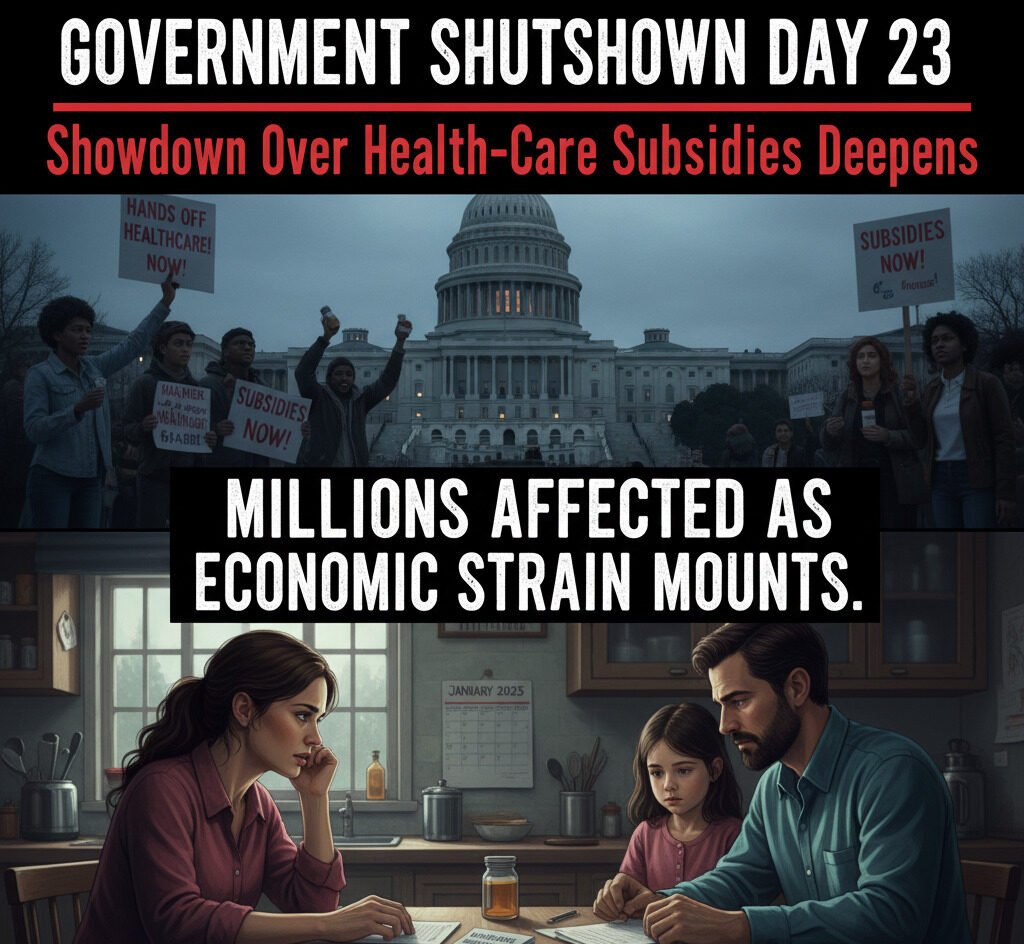Showdown Over Health-Care Subsidies Deepens, Millions Affected as Economic Strain Mounts.
Washington, D.C. — The U.S. government shutdown entered its 23rd day on Thursday, marking the second-longest closure in American history. It now trails only the 35-day shutdown of 2018–2019, which occurred during Donald Trump’s first term amid a fight over funding for a southern border wall.
This year’s standoff centers on a partisan impasse over expiring health-care subsidies under the Affordable Care Act. Democrats insist that extending the subsidies is essential to prevent 22 million Americans from facing steep premium hikes beginning in January, while Republicans have refused to approve any short-term relief without broader spending cuts.
White House Talks Collapse, Trump Digs In
President Donald Trump met with Senate Republicans at the White House on Tuesday, but the session appeared to harden the party’s stance rather than bring compromise closer.
“Our message has been very simple: we will not be extorted by this crazy plot of theirs,” Trump said after the meeting, signaling no immediate end to the stalemate.
Senate Democratic leader Chuck Schumer and House Minority Leader Hakeem Jeffries requested a meeting with the President before his upcoming Asia trip, but Trump made clear that he would not negotiate until the government reopens.
FCRF Launches CCLP Program to Train India’s Next Generation of Cyber Law Practitioners
Legislative Deadlock in the Senate
To pass a temporary spending bill that would reopen the government until November 21, Senate Republicans need at least eight Democratic votes to overcome a filibuster. Republican leader John Thune has pledged a floor vote on renewed ACA subsidies once federal operations resume, but Democrats remain unconvinced.
“That’s not a deal,” Schumer countered. “That’s a partisan plan that leaves the American people high and dry.”
Economic Fallout Widens
The economic toll of the prolonged shutdown is beginning to bite. Civilian federal employees, who received partial pay earlier this month, are expected to miss their first full paycheck on Friday. The White House has warned that extraordinary accounting maneuvers may soon fail to cover military salaries or key food-aid programs, potentially triggering widespread disruption.
The administration has already frozen or canceled $28 billion in federal projects — roughly ₹2.33 lakh crore — many of them in Democratic-majority states. Plans for mass layoffs in the Departments of Education, Health and Human Services, and Interior were temporarily blocked by court orders amid legal disputes over whether such cuts are permissible during a shutdown.
Historical Perspective
Since 1980, when U.S. administrations began furloughing federal employees during funding lapses, the current 2025 shutdown ranks second in duration:
- 2018–2019: 35 days — Triggered by a dispute over Trump’s $5.7 billion border-wall request.
- 2025: 23 days — Ongoing stalemate over health-care subsidies.
- 1995–1996: 22 days — Budget clash between President Bill Clinton and a Republican-led Congress.
- 2013: 16 days — Dispute over the Affordable Care Act and debt ceiling under President Barack Obama.
- 1995: 6 days — Prelude to the longer 1996 shutdown.
- 1990: 3 days — Deficit-reduction fight under President George H. W. Bush.
- 2018: 3 days — Brief closure over immigration protections for Dreamers.
Political Polarization Deepens
As the standoff drags on, Washington’s political paralysis has become more pronounced. Trump and his allies portray the Democrats’ position as “economic blackmail,” while Democrats accuse the President of weaponizing federal governance for political leverage.
Political analysts warn that an extended shutdown could undermine confidence in the U.S. economy, shake financial markets, and slow hiring in the months ahead — echoing the economic disarray of the 2018 shutdown.
“The real casualty here is not just government efficiency,” said one policy researcher in Washington, “but the credibility of American governance itself.”


